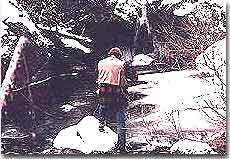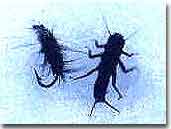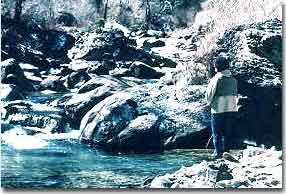Ice In The Guides or How Nymph Fishing Cures The Winter Blues
Ice In The Guides or How Nymph Fishing Cures The Winter Blues
By Bob Krumm
 The quarter moon is shining brightly over a foot of new snow. The temperature is headed towards zero and I'm thinking of fly fishing. Perhaps you might think that I have gotten frostbite of the brain or cabin fever has closed in on me.
The quarter moon is shining brightly over a foot of new snow. The temperature is headed towards zero and I'm thinking of fly fishing. Perhaps you might think that I have gotten frostbite of the brain or cabin fever has closed in on me.
Actually I am perfectly sane and my brain is not smitten by frost, it's just the days have started to get longer and soon the afternoon sun will reach into my favorite canyon stream and start to warm gradually. Pools will lose their ice mantle and the water will begin to warm ever so slowly.
With the warming water, the trout develop an appetite. While a trout won't feed voraciously, it will take a nymph if it drifts by close to the fish. I have found that trout don't feed as often when the water is cold, but they do feed and with patience and persistence, I can have a successful day of fly fishing on most mild days from late January through March.
In Wyoming, there are many trout streams that offer very good winter fishing. I find that canyon streams which have south or west exposures are probably the best. These streams will have areas that have plenty of sunlight. The backwaters of the pools might warm up three to five degrees above the overnight water temperature. Whenever the trout can warm up a bit over 39 degrees, Fahrenheit, you can bet that the fish will be feeding.
The canyon streams that I enjoy fishing are primarily in the Bighorn Mountains of north central Wyoming. These streams are well aerated and have a very diverse aquatic insect population, but, most importantly to me, they have a wealth of stoneflies and big mayflies.
 Instead of having to fish with small nymphs as I do most of the year on the Bighorn River, I can use large sizes, 8s and 10s. Fairly simple stonefly patterns work well for me: rat-faced Krumms, Montana nymphs, brown stonefly nymphs, and gold-ribbed hare's ears all work well for me.
Instead of having to fish with small nymphs as I do most of the year on the Bighorn River, I can use large sizes, 8s and 10s. Fairly simple stonefly patterns work well for me: rat-faced Krumms, Montana nymphs, brown stonefly nymphs, and gold-ribbed hare's ears all work well for me.
My winter fishing tackle isn't too fancy, a 9 foot, six weight medium action rod; a weight forward, floating fly line; and a 7 1/2 foot, 3 or 4 X leader. If my fly line is floating well, I might not even bother with a strike indicator because the trout usually take the big nymphs with gusto. The line will move four to six inches so I can usually see that. However, on days when I'm feeling insecure, I'll go back to using a small peg bobber so that I don't miss any strikes.
I usually treat my fly line liberally with a paste flotant, Mucilin, so that the fly line will float well and will be less likely to get sucked under by complex currents that are so common in canyon streams.
Since I weight my nymphs with lead wire when I tie them, I usually don't bother to put any shot on the leader. If I am not connecting to any fish in a deep pool, I will start adding shot, a BB at a time to get the nymph down to the fish. Remember, in nymph fishing, if you are in doubt, add weight.
I usually try to pick a day when the temperature is going to be above freezing and the higher above freezing, the better for me. There are many February days in Sheridan, Wyoming, my home, that the temperature reaches into the mid forties to lower fifties. They are ideal ones for me to go fishing. I don't like to contend with ice in the guides and battling hypothermia.
Though I fish on fairly nice days, the water is still going to be cold. I have a pair of Simms Exstream neoprene waders that are extra thick and have felt boots as liners. I have been very comfortable in these boots under some pretty miserable conditions.
I always wear capeline long underwear, fleece pants, a wool shirt, light weight nylon socks with wick-type heavier socks. I usually add a sweater and a good wind breaker jacket (Simms' Dry Jacket sure fills the bill). Fingerless wool gloves round out my wardrobe.
Of course, it always helps to have a brimmed hat and good, polarized sunglasses.
Those of you who know me are aware that I am not an early riser, so winter nymph fishing suits me just fine. There is no sense in getting to the stream at the crack of dawn or first light for it will be too cold to fish and the trout won't be feeding anyway. I enjoy sleeping in and getting to the stream when it's around 11:00 a.m. and then fishing until it cools down around 3:00 p.m. The middle of the day will have the warmest water temperatures and the trout will be moving around and feeding. (If I'm lucky I might stumble into a midge hatch, but that's another story).
When I nymph fish in the wintertime, I try to think slow. I try to visualize the trout in 40 degree water and how lethargic they must be. This visualization enables me to slow down and become very thorough.
 I concentrate on the pools and slow, deep runs. I know from experience that the trout will not be in the fast water--they just don't have the umph to stay in that type of water when the water temperature is low. I mentally grid the pool and try to cover the pool by first casting upstream toward the head on one side the of the creek. I let the nymph dead drift back down to me as I carefully watch the line or strike indicator. I try to make my next cast the same distance upstream and maybe four five inches further into the stream.
I concentrate on the pools and slow, deep runs. I know from experience that the trout will not be in the fast water--they just don't have the umph to stay in that type of water when the water temperature is low. I mentally grid the pool and try to cover the pool by first casting upstream toward the head on one side the of the creek. I let the nymph dead drift back down to me as I carefully watch the line or strike indicator. I try to make my next cast the same distance upstream and maybe four five inches further into the stream.
By gradually working my casts and drifts across the pool, I will eventually present my nymph to nearly every trout in the pool. Like my guide buddy, Dan Stein, says, "somedays you have to force feed them." In other words, when the water is cold the trout aren't going to move much so that nymph practically has to bump them on the nose for them to take.
If it is a particularly warm day, and the water temperature comes up into to the low to mid forties, I have seen the trout really put on the feed bag. On this type of day it is not unusual for the trout to move three feet or more to get a big stonefly nymph.
Fishing nymphs in many western streams will often bring you whitefish. My what a bonus that can be! I feel that any fish on the line is a heck of a lot better than no fish at all so I enjoy the action that whitefish can bring. I also enjoy the added variety to my diet. You see, I am one of those persons that enjoys eating smoked whitefish.
Preparing whitefish to smoke is relatively easy. Simply clean them as you would a trout, that is cut ahead of the gills, and slit from the anus to near the gills. Put your middle finger in the slit ahead of the gills, and holding onto the head with the other hand, gently break off the gills and eviscerate the fish. Run your thumb along the backbone to eliminate the dark matter, and rinse the fish out.
Soak the whitefish in a brine that has four cups of pickling salt and two cups of sugar per gallon of water. Soak them for 24 hours. Dry the fish off with paper towels and place in your smoker for 8 to 12 hours. I add some hickory or apple chips to give a good flavor.
Meanwhile, back at the stream. If you take your time you will have plenty of fishing action in a half dozen pools. Try to keep use what cover that is availabe because the stream will be gin clear and those warm sunny days will make tend to make the fish spooky.
Remember that fishing is supposed to be fun and enjoyable. This is your first outing of the year, and if you're like me, you'll make mistakes casting, get hung up on the backcast, or lose some flies to snags in the stream. So what? You're outside and fishing. Even a frustrating day of fishing is a lot better than sitting around at the job.
By the way, if it is your first fishing trip of the year, make sure to buy a current fishing license! Don't start of your season with an encounter with your game warden.
Good luck and tight lines. Bob Krumm
|
